Improving employee engagement in healthcare is an important responsibility of industry leaders. But, with the demands of their roles we understand it isn't easy . How can you help engage staff in such a challenging environment? Well we’ve got you covered with this blog.
An NHS study found that the average turnover rate for nurses per trust was around 10-12% per year and is even higher in some US states. Clearly disengagement, stress and enjoyment are all issues within healthcare and on a global scale.
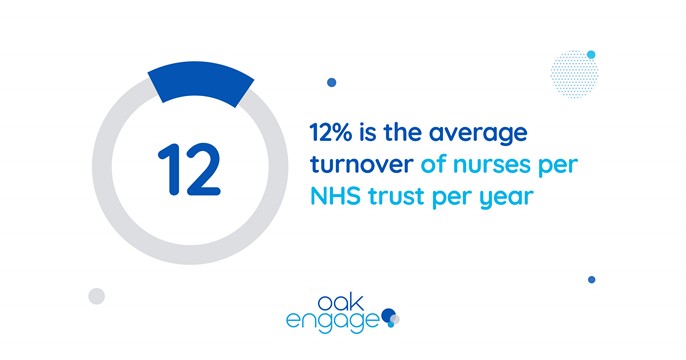
This being said, it is possible to keep health workers engaged and there are all sorts of hints and tips to suit all kinds of budgets.
In this blog we will show you how to improve employee engagement in healthcare. The answer to your prayers!
The blog includes:
- How to Improve Employee Engagement in Healthcare
- What is Employee Engagement in Healthcare?
- Why is it Important in the Healthcare Industry
- Reasons for Poor Employee Engagement in Healthcare
- How to Improve Employee Engagement in Healthcare
Employee engagement is important within any industry. Within healthcare it's essential - lives depend on it. A positive and inclusive culture paired with an effective communication strategy make for an efficient and productive workplace. Healthcare is fast paced and relentless, meaning those on the frontlines need the tools to be able to support their busy schedules and constant need for information.
Rachel Davison - Director of Marketing & People Oak Engage
What Is Employee Engagement in Healthcare?
Employee engagement is the emotional commitment someone has to their work and their sense of purpose in it. This applies to healthcare workers, but it also impacts the care that they give their patients.
A HealthCareSource study found that only 38% of disengaged employees displayed a genuinely caring attitude towards patients. Quite a worrying statistic to say the least!
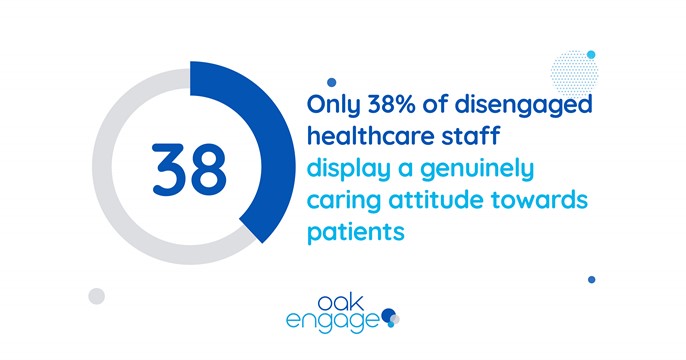
Just because an employee is disengaged, it doesn’t mean they’re not giving the best care they can in the circumstances. In fact, they might feel disengaged for this very reason.
They may be suffering from burnout, low morale and absenteeism, which is out of their control. Risks of a disenfranchised workforce need to be addressed by management.
Why Is It Important in the Healthcare Industry?
The consequences of disengaged healthcare workers are far starker than they are for other industries. Quality of care received by a patient will be linked to how engaged their caregiver is in their role. It can even be a matter of life and death.
A Gallup study found that employees who are burned out are 2.6 times more likely to look for another job and are 63% more likely to take a sick day. As a result you will have staff shortages, leading to further burnout in stretched workforces. It’s an endless cycle.
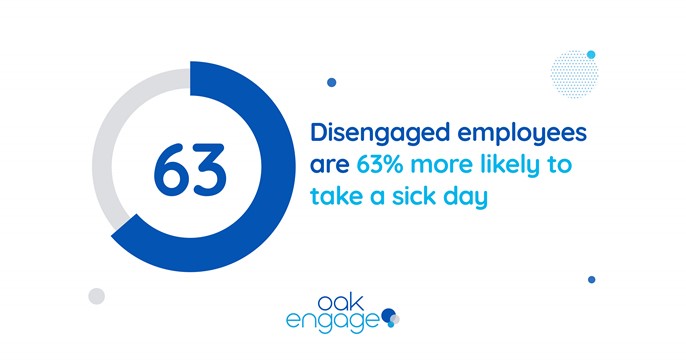
Reasons for Poor Employee Engagement in Healthcare
Healthcare workers have highly emotive roles, so the employee experience can vary dramatically from day to day. You can feel like a superhero one day and helpless the next.
However, there are some fundamental issues within the health sector that can lead to poor engagement levels. Here are a few common factors of poor engagement in healthcare. If you work in or around the industry, they might look a little familiar.
Lack of Investment
In healthcare, your budgets are often stretched to the limit. Investment in technology or employee initiatives can be a low priority and given the urgent need in several areas we can understand why.
However, the cost of high turnover and absenteeism as a result of disengagement makes the right kind of investment essential. When tackling these two common side effects of poor engagement, you will see significant ROI.
By not giving your employees the tools to support them in their role, you aren’t doing them any favours. It will also inevitably increase recruitment spend and sick pay. Whilst it may cut short term costs, no investment into engagement is rather short sighted. Improving employee engagement in the healthcare industry is dependent on support - both financially and institutionally.
High Turnover
If you haven’t experienced stressed front-line workers handing in or considering handing in their notice in the past year, then either you’re extremely fortunate or don’t work in healthcare.
On the subject of employee turnover, staff shortages are a huge contributor to employee engagement in healthcare. Given the pressures already put on workers, a lack of personnel will lead to burnout and exhaustion.
The timely nature of getting staff onboarded, shortages in specific departments will leave individuals unable to cope with the demands of the role. Employees may leave as a result of poor engagement, but the high turnover itself will intensify the issues.
Lack of Health & Wellbeing Resources
The hours they work and the stress they are under is bound to impact healthcare workers’ wellbeing. You need a lot of resilience to work in health.
A University of London study found that more than 1 in 4 healthcare workers have sought out mental health support during the pandemic. Who looks after the doctors and nurses?
Clearly mental health is a prominent issue in the healthcare profession. Failure to combat it is a failure that will lead to rock bottom morale within teams. A lack of services available for staff makes this an inevitability.
How to Improve Employee Engagement in Healthcare
Getting visions of hoards of stressed workers knocking on your door with resignation letters? Fear not. We may have the antidote.
Despite the pressures that come with the industry, there are simple and effective measures to put in place. Here are five tips ways to improve employee engagement in healthcare:
Implement a Mobile App
Healthcare is a predominantly deskless workforce, particularly direct caregivers. It is difficult to keep employees connected and engaged when accessibility to company information is limited. Improving employee engagement in healthcare involves improving methods of communication.
A modern intranet app allows employees to access all the company info they need when they need it. Oak’s integrated push notifications alert workers through their app on urgent updates that are relevant to them. This is helpful for any shift changes or legislation that needs to be considered. One less thing on their plate.
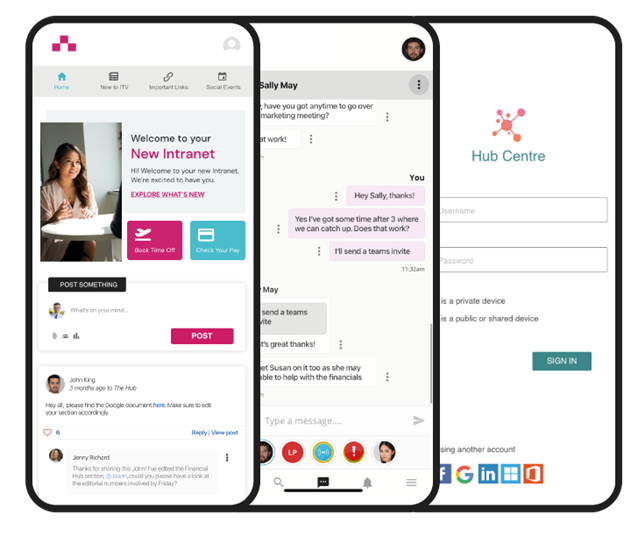
Recommended Reading 📖: What is an Employee Engagement App?
Recognise & Reward
Employee engagement in healthcare is more about impactful messaging. Healthcare workers go above and beyond constantly, but that doesn’t mean a bit of praise wouldn’t give them a little boost. A ‘thank you’ post on your intranet social feed can help them reflect the importance of their contribution.
Recognising staff through your intranet also highlights achievements to the rest of the organisation. It can help to inspire and realign the rest of the workforce to create a better culture.
A simple act of kindness can make a world of difference. Having an intranet with built in recognition tools makes it even simpler.

Recommended Reading 📖: Employee Recognition in the Workplace [A Complete Guide]
Encourage Team Building and Socialising
Are you encouraging employees to build friendships at work? Of course it may not be a high priority, but having work friends can actually help staff be more productive. 22% of employees say working alongside friends makes them more productive. To improve employee engagement in healthcare, supporting strong, social bonds is imperative. Building strong foundations makes for a sturdier
Give them a space to speak about mutual interests, instant chats to organise social events and an online calendar to organise them! Having friends at work makes it that much easier to confide in each other and put some fun back into their jobs.
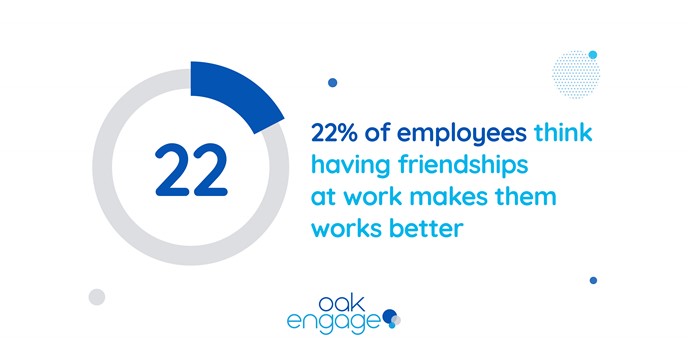
Get Feedback
Sometimes you just have to ask….
Surveys and feedback forms are a great way to evaluate how your employees feel about their role. Asking direct questions like ‘how well does leadership communicate with you?’ as part of a survey, will provide honesty and practical suggestions. Building a culture with your employees helps instil a sense of belonging and inclusion throughout your business.
Formalised feedback will also help to integrate it into the culture of the organisation, which will encourage more transparency throughout. Then you will have the knowhow to make changes and engage employees further.

Recommended Reading 📖: 24 Employee Pulse Survey Questions to Ask in 2021
Keep Everything Centralised and in One Place
Healthcare workers have a pretty stressful job as it is, right? Well, having policies, staff rotas and other company info in disparate locations aren’t going to help matters.
Oak’s solution can house a centralised content hub, document management platform, rotas and payslips under one proverbial roof! It is a weight lifted off the shoulders of your employees and makes their jobs that little bit easier.
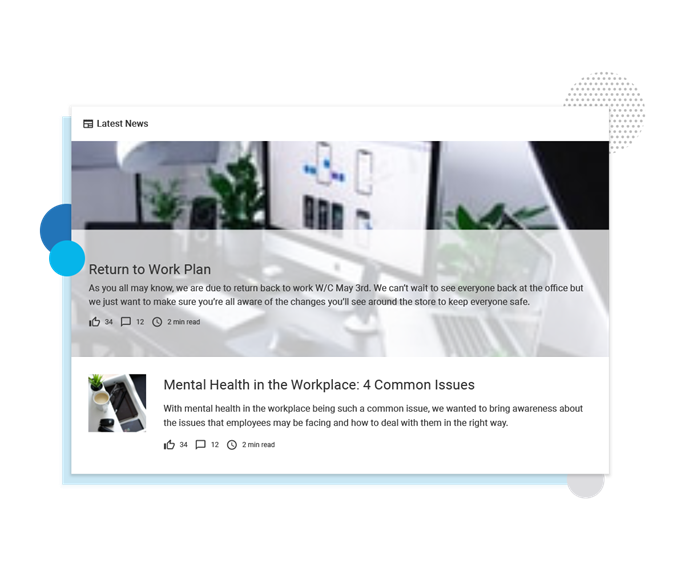
Oak Engage - Keeping Frontline Workers On The Move
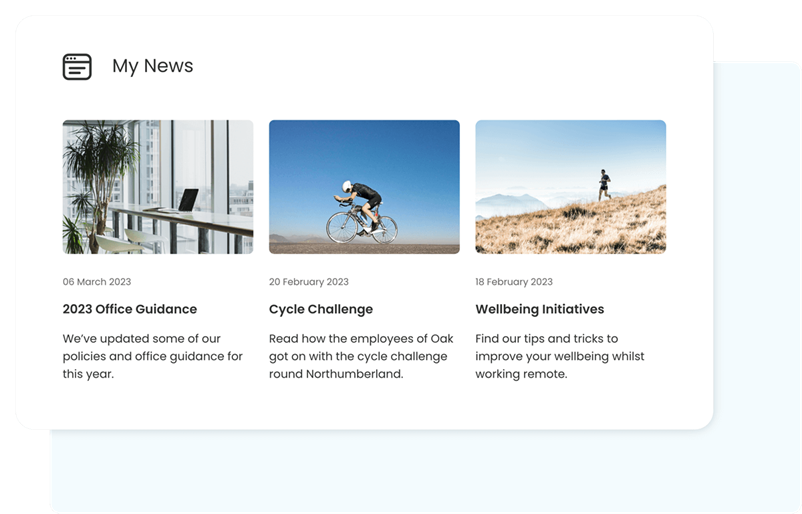
Oak Engage introduces a wide range of benefits that have a profound impact on employee engagement in the healthcare industry. By promoting seamless connectivity, the app enables healthcare professionals to communicate effortlessly and build stronger relationships. Whether it's connecting with colleagues in different departments or sharing insights and expertise, Oak Engage breaks down communication barriers and fosters a collaborative work environment. This enhanced connectivity leads to improved teamwork, better coordination of patient care, and increased employee engagement.
In addition to connectivity, Oak Engage revolutionises knowledge sharing within healthcare organisations. The app streamlines document management, making critical information easily accessible to employees. By providing a centralised platform for storing and sharing policies, procedures, and best practices, Oak Engage enables healthcare professionals to find the information they need quickly and efficiently. This efficient knowledge sharing promotes continuous learning, allowing employees to stay up-to-date with the latest research, advancements, and evidence-based practices. Access to valuable resources empowers healthcare professionals to deliver high-quality care and feel more engaged and confident in their roles.
Furthermore, Oak Engage's curated newsletter updates play a vital role in engaging healthcare employees. These updates deliver personalised content tailored to individual interests and needs. By providing relevant industry insights, research findings, and educational resources, the app keeps employees informed about emerging trends and developments in their field. This curated approach ensures that healthcare professionals receive information that is directly applicable to their roles and helps them expand their knowledge and expertise. By staying informed and engaged with the latest industry updates, healthcare professionals feel empowered, valued, and motivated in their work.
In summary, Oak Engage brings a multitude of benefits to the healthcare industry, including enhanced connectivity, streamlined knowledge sharing, and curated content delivery. These features create a collaborative environment, support continuous learning, and keep employees informed and engaged with the latest industry trends. By leveraging these benefits, healthcare organisations can foster a culture of collaboration, innovation, and ongoing professional development, leading to improved patient care and overall organisational success.
Ready to revolutionise employee engagement in your healthcare organisation? Book a demo of Oak Engage today to discover how our app can transform communication, knowledge sharing, and employee satisfaction. Experience firsthand the power of seamless connectivity and curated content delivery tailored to the unique needs of the healthcare industry.
Employee Engagement In Healthcare FAQs
How to Create SMART Goals for Employee Engagement in Healthcare?
Implementing a SMART goal for employee engagement in healthcare involves clear communication, resource allocation, and executing a well-defined action plan. Start by communicating the goal's importance to all stakeholders and securing the necessary resources for training, mentorship, and feedback mechanisms.
Execute the action plan by assessing current nurse retention rates and gathering feedback. Identify specific areas for improvement and develop actionable strategies, assigning clear responsibilities. Monitor progress through feedback mechanisms, be adaptable in response to challenges, and celebrate successes.
Leadership support is crucial, and ongoing data analysis is necessary to track trends and areas needing attention. Maintain open communication with stakeholders and, after the initial 12-month timeframe, evaluate the goal's success to refine strategies for continuous improvement. Employee engagement in healthcare is an ongoing process, requiring dedication and collaboration to create a positive work environment for better patient care and organisational success.
Ways to Improve Work Performance in Healthcare?
Improving work performance in healthcare is paramount for delivering high-quality patient care and optimising the functioning of healthcare organisations. One crucial strategy is continuous training and development. Healthcare professionals, including nurses, doctors, and support staff, should have access to ongoing training programs to stay updated on the latest medical advancements and best practices. Such initiatives not only sharpen clinical skills but also promote improved communication, teamwork, and leadership abilities among the healthcare workforce, ultimately leading to better patient outcomes.
Streamlining workflows is another vital step. Healthcare institutions can invest in electronic health records (EHR) systems and automation to minimise administrative tasks, paperwork, and the risk of errors. By simplifying and standardising processes, healthcare providers can spend more time on direct patient care, enhancing both efficiency and the quality of care provided.
Effective communication and collaboration are equally critical. Promoting an open and collaborative culture among healthcare teams can significantly improve patient care. Encouraging interdisciplinary teamwork among nurses, physicians, pharmacists, and other healthcare professionals helps ensure that patient needs are met comprehensively. Employing robust communication tools and holding regular team meetings can enhance coordination, reduce misunderstandings, and improve overall patient outcomes. Moreover, recognising and celebrating the contributions of healthcare staff boosts morale and motivation, fostering a positive work environment that supports better performance and patient care.
Take the first step towards a more engaged and connected healthcare team by booking your demo of Oak Engage now.



